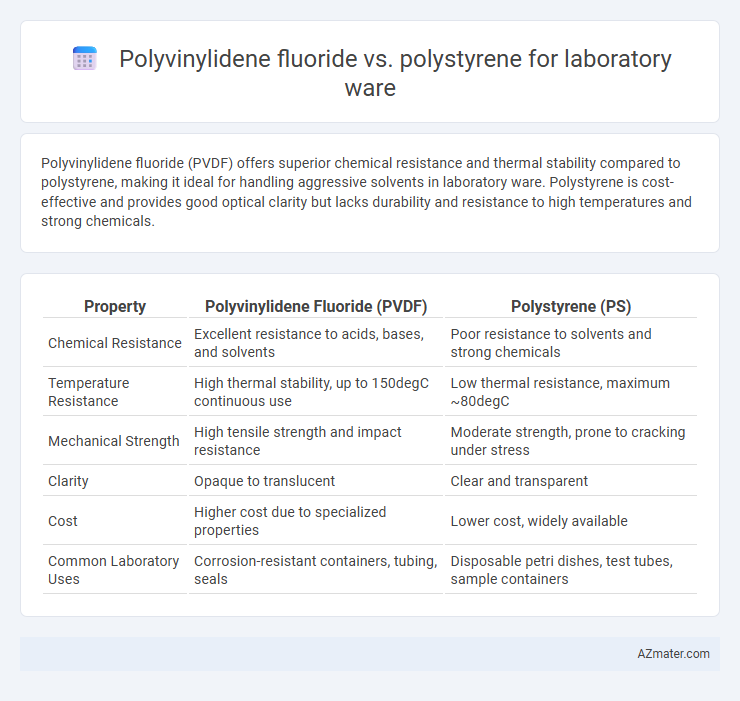Polyvinylidene fluoride (PVDF) offers superior chemical resistance and thermal stability compared to polystyrene, making it ideal for handling aggressive solvents in laboratory ware. Polystyrene is cost-effective and provides good optical clarity but lacks durability and resistance to high temperatures and strong chemicals.
Table of Comparison
| Property | Polyvinylidene Fluoride (PVDF) | Polystyrene (PS) |
|---|---|---|
| Chemical Resistance | Excellent resistance to acids, bases, and solvents | Poor resistance to solvents and strong chemicals |
| Temperature Resistance | High thermal stability, up to 150degC continuous use | Low thermal resistance, maximum ~80degC |
| Mechanical Strength | High tensile strength and impact resistance | Moderate strength, prone to cracking under stress |
| Clarity | Opaque to translucent | Clear and transparent |
| Cost | Higher cost due to specialized properties | Lower cost, widely available |
| Common Laboratory Uses | Corrosion-resistant containers, tubing, seals | Disposable petri dishes, test tubes, sample containers |
Introduction to Laboratory Plastics: An Overview
Polyvinylidene fluoride (PVDF) and polystyrene (PS) are prominent materials used in laboratory ware, each offering unique chemical and mechanical properties suited for different applications. PVDF is prized for its exceptional chemical resistance, thermal stability up to 150degC, and durability in corrosive environments, making it ideal for containers and tubing handling aggressive solvents. Polystyrene, on the other hand, is valued for its optical clarity and ease of molding, commonly used in disposable petri dishes, test tubes, and pipettes where cost-effectiveness and transparency are critical.
Chemical Structure: Polyvinylidene Fluoride vs Polystyrene
Polyvinylidene fluoride (PVDF) is a fluoropolymer characterized by a repeating vinylidene fluoride unit with strong carbon-fluorine bonds, providing exceptional chemical resistance and thermal stability. Polystyrene (PS) consists of a hydrocarbon chain with phenyl groups attached, resulting in a rigid, aromatic polymer but with lower chemical and solvent resistance compared to PVDF. The fluorinated backbone of PVDF imparts superior durability against aggressive chemicals, making it suitable for demanding laboratory ware applications where polystyrene's simpler aromatic structure is prone to swelling and degradation.
Mechanical Strength and Durability Comparison
Polyvinylidene fluoride (PVDF) exhibits superior mechanical strength and chemical resistance compared to polystyrene, making it ideal for laboratory ware exposed to harsh solvents and high stress. PVDF's enhanced durability ensures long-term performance under repeated use, while polystyrene, though cost-effective and lighter, is more prone to brittleness and degradation upon prolonged exposure to chemicals and physical impact. This makes PVDF the preferred choice for critical applications requiring robust mechanical stability and sustained material integrity.
Chemical Resistance Profiles
Polyvinylidene fluoride (PVDF) offers exceptional chemical resistance against strong acids, bases, and organic solvents, making it ideal for laboratory ware exposed to harsh chemicals. Polystyrene shows limited resistance to many solvents and can degrade when exposed to acetone, benzene, or chlorinated solvents, restricting its use in aggressive chemical environments. PVDF's superior durability in corrosive conditions ensures longer lifespan and reliability for lab containers, tubing, and filtration components compared to polystyrene.
Thermal Stability and Temperature Tolerance
Polyvinylidene fluoride (PVDF) exhibits superior thermal stability compared to polystyrene (PS), maintaining structural integrity at temperatures up to 150degC, whereas polystyrene typically deforms above 90degC. PVDF's chemical resistance and high melting point around 172degC make it ideal for high-temperature laboratory applications requiring durable containers and tubing. Polystyrene's lower thermal tolerance and susceptibility to warping limit its use in experiments involving elevated temperatures or prolonged heat exposure.
Optical Properties and Transparency
Polyvinylidene fluoride (PVDF) offers excellent chemical resistance but has limited optical transparency, making it less suitable for applications requiring clear visibility in laboratory ware. Polystyrene (PS) exhibits high transparency and excellent optical clarity, allowing for precise visual inspection of samples and reactions. For laboratory equipment where optical properties and transparency are critical, polystyrene is typically preferred over PVDF.
Biocompatibility and Impurity Leaching
Polyvinylidene fluoride (PVDF) exhibits superior biocompatibility compared to polystyrene, making it preferable for sensitive laboratory applications involving biological samples. PVDF's low impurity leaching ensures minimal contamination, critical for accurate experimental results and maintaining sample integrity. Polystyrene, while cost-effective, tends to leach higher levels of residual monomers and additives, posing a risk for bioassays requiring stringent purity.
Sterilization Compatibility and Cleaning Methods
Polyvinylidene fluoride (PVDF) offers superior chemical resistance and thermal stability, making it highly compatible with autoclaving and aggressive sterilization methods like gamma irradiation, commonly required in laboratory ware. Polystyrene, while cost-effective and clear, has limited tolerance to heat and chemical sterilization, often deforming under autoclave conditions and requiring ethylene oxide or chemical disinfectants for cleaning. For rigorous cleaning protocols involving solvents or high-temperature sterilization cycles, PVDF ensures durability and maintains structural integrity better than polystyrene.
Typical Laboratory Applications: PVDF vs PS
Polyvinylidene fluoride (PVDF) is widely used in laboratory ware for applications requiring exceptional chemical resistance, such as handling strong acids and bases, and in filtration systems for analytical chemistry due to its low extractables and high purity. Polystyrene (PS), by contrast, is commonly employed in disposable labware like petri dishes, test tubes, and culture plates where optical clarity and cost-effectiveness are prioritized over chemical resistance. PVDF's robust thermal stability and solvent resistance make it ideal for reusable containers and filtration membranes, while PS suits routine biological assays and microbiological cultures where moderate chemical resistance is sufficient.
Cost Considerations and Environmental Impact
Polyvinylidene fluoride (PVDF) laboratory ware generally incurs higher upfront costs compared to polystyrene (PS) due to its superior chemical resistance and durability, which extends product lifespan and reduces replacement frequency. Polystyrene is more cost-effective initially but tends to degrade faster under chemical exposure, potentially increasing long-term expenses and waste. Environmentally, PVDF is more resistant to chemical leachates and can be recycled more efficiently, whereas polystyrene's widespread use contributes significantly to plastic pollution and is less biodegradable, raising concerns over its environmental footprint.

Infographic: Polyvinylidene fluoride vs Polystyrene for Laboratory ware
 azmater.com
azmater.com